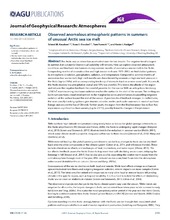Observed anomalous atmospheric patterns in summers of unusual Arctic sea icemelt
Peer reviewed, Journal article
Published version
Permanent lenke
https://hdl.handle.net/1956/9858Utgivelsesdato
2015-04-16Metadata
Vis full innførselSamlinger
- Geophysical Institute [1195]
Originalversjon
https://doi.org/10.1002/2014jd022608Sammendrag
The Arctic sea ice retreat has accelerated over the last decade. The negative trend is largest in summer, but substantial interannual variability still remains. Here we explore observed atmospheric conditions and feedback mechanisms during summer months of anomalous sea ice melt in the Arctic. Compositing months of anomalous low and high sea ice melt over 1979–2013, we find distinct patterns in atmospheric circulation, precipitation, radiation, and temperature. Compared to summer months of anomalous low sea ice melt, high melt months are characterized by anomalous high sea level pressure in the Arctic (up to 7 hPa), with a corresponding tendency of storms to track on a more zonal path. As a result, the Arctic receives less precipitation overall and 39% less snowfall. This lowers the albedo of the region and reduces the negative feedback the snowfall provides for the sea ice. With an anticyclonic tendency, 12 W/m2 more incoming shortwave radiation reaches the surface in the start of the season. The melting sea ice in turn promotes cloud development in the marginal ice zones and enhances downwelling longwave radiation at the surface toward the end of the season. A positive cloud feedback emerges. In midlatitudes, the more zonally tracking cyclones give stormier, cloudier, wetter, and cooler summers in most of northern Europe and around the Sea of Okhotsk. Farther south, the region from the Mediterranean Sea to East Asia experiences significant surface warming (up to 2.4°C), possibly linked to changes in the jet stream.
Utgiver
WileyAmerican Geophysical Union
